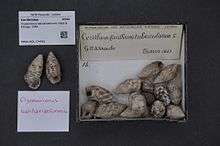Clypeomorus batillariaeformis
Clypeomorus batillariaeformis, common name : the necklace or channeled cerith, is a species of sea snail, a marine gastropod mollusk in the family Cerithiidae.[1]
| Clypeomorus batillariaeformis | |
|---|---|
 | |
| Diverse shell of Clypeomorus batillariaeformis (museum specimens) | |
| Scientific classification | |
| Kingdom: | |
| Phylum: | |
| Class: | |
| (unranked): | |
| Superfamily: | |
| Family: | |
| Subfamily: | Cerithiinae |
| Genus: | |
| Species: | C. batillariaeformis |
| Binomial name | |
| Clypeomorus batillariaeformis Habe & Kosuge, 1966 | |
| Synonyms[1] | |
| |
Description
The shell size varies between 8 mm and 30 mm
Distribution
The distribution of Cerithium moniliferum includes the Indo-West Pacific.[2] along Japan, the Solomons, the Fiji Islands, Heron Island, Australia,[3] Indonesia[2] and the Philippines; in the Indian Ocean along Madagascar[2] and the Mascarene Basin and in the Red Sea[2]
Life habits
These animals form large groups as the tide recedes. Feeding on beach rock at a specific height above average low tide level, the snails slowly move about in clusters, conserving the moisture that allows them to respire out of water.[3]
Parasites
Parasites of Clypeomorus batillariaeformis include Lobatostoma manteri.[4][5]
References
- Clypeomorus batillariaeformis Habe & Kosuge, 1966. Retrieved through: World Register of Marine Species on 9 February 2011.
- Cerithium moniliferum. sealifebase.org, accessed 3 May 2009.
- Fosberg, F.R.; Thorne, R.F. & Moulton, J.M. (1961): Heron Island, Capricorn Group, Australia. Atoll Research Bulletin 82: 1-16. PDF fulltext Archived 9 April 2008 at the Wayback Machine
- Klaus Rohde. 1998. Effects of Aspidogastrea on the Host. Tree of Life, accessed 3 May 2009.
- Alevs, Philippe V.; Vieira, Fabiano M.; Santos, Cláudia P.; Scholz, Tomáš; Luque, José L. (12 February 2015). "A Checklist of the Aspidogastrea (Platyhelminthes: Trematoda) of the World". Zootaxa. 3918 (3): 339–96. doi:10.11646/zootaxa.3918.3.2. ISSN 1175-5334. PMID 25781098.
- Dautzenberg, Ph. (1929). Mollusques testaces marins de Madagascar. Faune des Colonies Francaises, Tome III
- Drivas, J. & M. Jay (1988). Coquillages de La Réunion et de l'île Maurice
External links
- "Clypeomorus batillariaeformis". Gastropods.com. Retrieved 9 February 2011.
| Wikimedia Commons has media related to Clypeomorus batillariaeformis. |